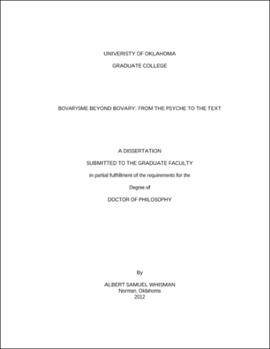| dc.contributor.advisor | Genova, Pamela A | |
| dc.creator | Whisman, Albert Samuel | |
| dc.date.accessioned | 2019-04-27T21:36:07Z | |
| dc.date.available | 2019-04-27T21:36:07Z | |
| dc.date.issued | 2012 | |
| dc.identifier | 99329195702042 | |
| dc.identifier.uri | https://hdl.handle.net/11244/319115 | |
| dc.description.abstract | "Bovarysme Beyond Bovary: From the Psyche to the Text," centers on examining the notion of bovarysme as a particular stance on literature, as well as a specific literary technique, and seeks to establish the emergence of a textualized bovarysme in selected works by Gustave Flaubert. Jules de Gaultier's 1902 definition of bovarysme as "le pouvoir départi à l'homme de se concevoir autre qu'il n'est," while useful as a point of departure, focuses largely on the psychology of the fictional character and does not extend the notion's implications further, such as into the realm of literary art. I therefore investigate if Gaultier's definition of bovarysme could apply to writing. Can language also conceive of itself other than what it is? | |
| dc.description.abstract | Working from this key question, I organize my study into four chapters that address the textualization of bovarysme. In Chapter One, "Madame Bovary and `La Maladie de la lecture'," I trace the development of bovarysme in relation to the desire to transpose reading onto reality, a transposition that exhibits contaminating effects that posit bovarysme as a "textually transmitted disease" (in the words of Daniel Pennac), as a condition that originates from the fictional realm, but extends also into the real, and influences not just Emma Bovary's comportment, but equally that of future generations of readers. | |
| dc.description.abstract | Chapter 2, "Bouvard et Pécuchet: The Caging of the Parrot," examines the mimetic properties of bovarysme as a textualized stance against the infectious power of clichés and idées reçues. Here, I argue that Flaubert's skillful use of italics and quotation marks seem to "quarantine" the linguistic properties of clichés, and yet simultaneously participate in their usage. Through the (mis)reading of linguistic signs, imbued with received ideas or linguistic platitudes, I argue that not only do Bouvard and Pécuchet read--and, especially, misread clichés--but also, readers of Bouvard et Pécuchet often perform a similar function by perceiving clichés and idées reçues merely as cultural references instead of representing as well an aesthetic stance against the forces of bêtise. | |
| dc.description.abstract | Chapter 3, entitled "Le Dictionnaire des idées reçues: Writing the Paradox," elaborates the ways in which the Dictionnaire problemetizes the power of words through the suggestiveness of rhetorical figures. I also analyze Flaubert's transformation of the genre of the dictionary into a ludic space in which to examine the self-reflexive properties of language. Additionally, I also aim to demonstrate that the text represents Flaubert's most notable attack against the pervasive idea of bêtise, as he seeks ultimately to expose the fallacy of the notion through its reification in dictionary form. Adding to this argument, I show that Flaubert's attempt to sequester bêtise reveals the author's own struggles with the inability of language to depict reality, producing a linguistic tension between literary and social discourse that may be seen to create a certain impossibility of writing anything original. I conclude the chapter by proposing that this impossibility culminates in the Dictionnaire. One can thus add the form of the dictionary to the list of techniques of quotation marks and italics, as a form that presents the cliché in its most isolated form, almost entirely devoid of contextual references. | |
| dc.description.abstract | Chapter 4, "The Posterity of Bovarysme or the Edifice Complex," I investigate the embodiment of bovarysme far beyond the nineteenth century, as it continues to emerge in a series of recent fictional texts that deliberately engage Flaubert as a precursor to honor or to challenge. I argue that contemporary authors such as Christophe Claro, Alain Ferry, Raymond Jean, and Philippe Doumenc contribute to the posterity of bovarysme in that, reversing the gesture of the fictional Emma choosing models from other authors, it is now the real-life authors choosing Emma as model, creating their own texts, variations on the theme of Flaubert's novel. In my view, this more contemporary bovarysme is not specifically on or about Flaubert, but rather "after him," which, both stylistically and chronologically, raises the question: "What is it to write or read after Flaubert?" | |
| dc.format.extent | 185 pages | |
| dc.format.medium | application.pdf | |
| dc.language | en_US | |
| dc.relation.requires | Adobe Acrobat Reader | |
| dc.subject | French literature--History and criticism | |
| dc.subject | Psychology in literature | |
| dc.title | Bovarysme Beyond Bovary: From the Psyche to the Text | |
| dc.type | text | |
| dc.type | document | |
| dc.thesis.degree | Ph.D. | |
| ou.group | College of Arts and Sciences::Department of Modern Languages, Literatures, and Linguistics | |
